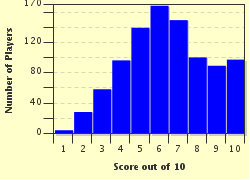Quiz Answer Key and Fun Facts
1. This question is about sheep, in view of the quiz title. Three of these are breeds of sheep, but one is a different kind of animal. Which is the odd one out?
2. There are several collective nouns for a group of ostriches. Which of these is NOT one of them?
3. Which of these common plants is toxic to cats?
4. What name is given to the young of a hamster?
5. What name is given to the ducks which feed mainly at the surface, rather than by diving?
6. In which of these countries would you NOT normally find a polar bear in the wild?
7. What name is given to a male ferret which has been neutered?
8. Which of a pig's senses is most efficient?
9. Most dogs can swim well, but not all. Which of these is a poor swimmer?
10. Myxomatosis is a disease caused by a virus which affects which of these wild mammals?
Source: Author
rossian
This quiz was reviewed by FunTrivia editor
crisw before going online.
Any errors found in FunTrivia content are routinely corrected through our feedback system.

